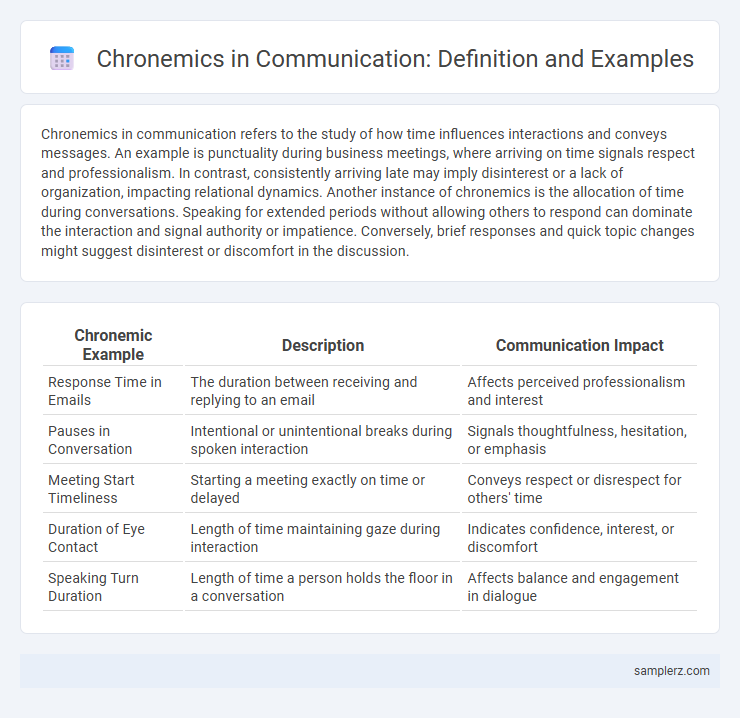Chronemics in communication refers to the study of how time influences interactions and conveys messages. An example is punctuality during business meetings, where arriving on time signals respect and professionalism. In contrast, consistently arriving late may imply disinterest or a lack of organization, impacting relational dynamics. Another instance of chronemics is the allocation of time during conversations. Speaking for extended periods without allowing others to respond can dominate the interaction and signal authority or impatience. Conversely, brief responses and quick topic changes might suggest disinterest or discomfort in the discussion.
Table of Comparison
| Chronemic Example | Description | Communication Impact |
|---|---|---|
| Response Time in Emails | The duration between receiving and replying to an email | Affects perceived professionalism and interest |
| Pauses in Conversation | Intentional or unintentional breaks during spoken interaction | Signals thoughtfulness, hesitation, or emphasis |
| Meeting Start Timeliness | Starting a meeting exactly on time or delayed | Conveys respect or disrespect for others' time |
| Duration of Eye Contact | Length of time maintaining gaze during interaction | Indicates confidence, interest, or discomfort |
| Speaking Turn Duration | Length of time a person holds the floor in a conversation | Affects balance and engagement in dialogue |
Understanding Chronemics: The Role of Time in Communication
Chronemics examines how individuals perceive and utilize time in communication, influencing interaction patterns and relationship dynamics. Examples include punctuality, the length of pauses in conversations, and culturally specific attitudes toward deadlines and response times. Understanding these temporal cues enhances effective communication by aligning expectations and reducing misunderstandings across diverse contexts.
Chronemics in Face-to-Face Interactions
Chronemics in face-to-face interactions refers to how individuals use and perceive time during communication, such as punctuality, pauses, and response latency. For instance, arriving late to a meeting can signal disrespect or lack of interest, while timely responses indicate attentiveness and engagement. The length and timing of pauses during conversations influence turn-taking dynamics and convey meaning beyond words.
The Impact of Response Time in Digital Communication
Response time in digital communication significantly influences perceived urgency and relationship dynamics, with faster replies often interpreted as higher engagement or priority. Studies indicate that delays exceeding 24 hours can decrease trust and satisfaction, impacting collaboration efficiency in professional settings. Chronemic cues in messaging platforms help convey tone and intent, emphasizing the critical role of timely responses in effective communication.
Punctuality as a Cultural Chronemic Cue
Punctuality serves as a crucial cultural chronemic cue, indicating respect and reliability across various societies. In cultures such as Germany and Japan, strict adherence to time schedules reflects professionalism and social discipline. Conversely, in countries like Brazil or India, flexible time perceptions often emphasize relational priorities over rigid punctuality.
Waiting Time and Power Dynamics in Conversations
Waiting time in conversations often signifies power dynamics, with those in authority typically controlling the pacing and duration of exchanges. Extended pauses imposed by dominant speakers can create a sense of impatience or submission, reinforcing hierarchical relationships. Understanding chronemics reveals how time management in dialogue shapes perceived status and influences interpersonal communication effectiveness.
Time Usage in Professional Meetings
Effective chronemic communication in professional meetings involves punctuality, allocation of specific time slots for agenda items, and respecting the scheduled duration to ensure efficient use of time. Managing meeting length influences participants' engagement and productivity, reflecting organizational respect for employees' time. Observing cultural differences in time perception can enhance cross-cultural communication and prevent misunderstandings during global meetings.
Turn-Taking and Pauses in Verbal Exchanges
Turn-taking in communication allows speakers to exchange information smoothly by following culturally understood timing cues, preventing interruptions and overlapping speech. Pauses serve as important chronemic signals that indicate reflection, emphasize points, or signal a transition between speakers during verbal exchanges. These temporal elements help manage conversational flow, enhance understanding, and maintain engagement in interactive dialogues.
Cross-Cultural Differences in Chronemic Behaviors
Chronemic behaviors reveal significant cross-cultural differences, such as monochronic cultures like the United States valuing punctuality and structured time management, while polychronic cultures like Mexico prioritize relational interactions over strict adherence to schedules. These variations influence communication patterns, where delays might be seen as disrespectful in some cultures yet considered normal or even polite in others. Understanding these distinctions is crucial for effective intercultural communication and avoiding misunderstandings related to time perception.
Scheduling and Time Management as Communication Signals
In communication, chronemics plays a critical role through scheduling and time management, signaling respect, priority, and urgency in interactions. For instance, punctuality in meetings conveys professionalism and commitment, while delays may indicate disinterest or power dynamics. The strategic use of time, such as allocating specific durations for discussions, reflects organizational efficiency and communication intent.
Nonverbal Chronemic Messages in Everyday Life
Nonverbal chronemic messages play a crucial role in everyday communication by conveying attitudes and emotions through the use of time. For instance, punctuality often signals respect and professionalism, while tardiness may indicate disinterest or disrespect. The amount of time spent in conversations can also reflect relationship closeness, where extended interaction suggests strong social bonds and brief exchanges imply formality or detachment.

example of chronemic in communication Infographic
 samplerz.com
samplerz.com